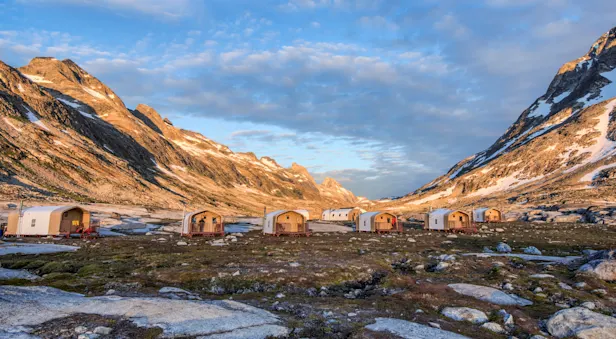Know Before You Go
Minke Whale Facts | Greenland Wildlife Guide
Physical Characteristics
The smallest and most abundant of the rorquals, the minke whale has a streamlined, but less slender body than its larger relatives, with an average length of about 25 to 30 feet. The narrow, pointed head has a ridge running along the center of the rostrum, which is triangular in shape. The ridge is located at the front of the blowhole.
Members of this species have dark gray, black or brown coloring, with lighter bellies and flipper undersides. The most notable trait is a diagonal, alabaster band on the upper portion of each small, pointed flipper, the extent and orientation of which varies by individual. Minke whales generally weigh between five and ten tons.
Like fin whales, minkes will occasionally have light gray coloring behind their heads, on their backs, and on their sides—behind the flipper and in the lower front of the dorsal fin. The dorsal fin is tall and falcate, positioned quite far forward and normally becomes visible simultaneously with the blow. The tail flukes, which are broad and smoothly concave along the notched rear edge, vary in colors of white, faint gray, or blue-gray on the underside. A minke whale’s belly and throat have between 50 and 70 ventral pleats, which end towards the front of the navel.
The short baleen plates of the minke whale are mostly gray or yellowish-white in color, with fine, white bristles, and may be black or streaked towards the back. There are 230 to 330 pairs of baleen plates, which are sometimes visible when the whale is feeding.
Habitat
Minke whales are widely distributed throughout the world, they live in every ocean and in a number of connected seas from the tropics to the poles. They are most often seen in coastal and inshore waters and are generally more common in cooler waters, such as along the coast of Greenland, than the tropics.
Feeding Habits
Minke whales are generally seen alone or in small pods, in areas of food abundance, however, there can be can be a feeding assembly made up of more than a thousand whales. There is some variation in diet regionally, as minke whales tend to feed on whatever food source is most abundant in a given area. In the North Atlantic, they are known to eat an array of sea creatures, including cod, mackerel, capelin, sand eel, copepods, and krill. Minke whales appear to feed very little in tropical and subtropical waters.
Feeding minke whales are often seen near the surface, chasing fish. With open mouths, they swim forward to engulf their food. Water and debris expel through baleen plates when the mouth is closed, and the baleen bristles capture the prey, which is then swallowed.
Behavior
Minkes are fast, dolphin-like swimmers, traveling the surface at speeds of up to 16 miles-per-hour. They are more likely than other rorquals to be seen up-close, as they often approach boats, especially stationary vessels, and are notoriously inquisitive. They also breach more often than other rorquals, surging fully out of the water and diving with a great splash. They tend to breach most frequently during feeding periods.
While larger whales may surface regularly, a minke’s blow begins below the surface, meaning it can be low and insubstantial. Normally, the breathing sequence involves five to eight blows at intervals of less than a minute, followed by a dive lasting about 20 minutes. When diving, the tailstock is arched high, but the fluke does not appear.
The migrations of minke whales are not as well defined as those of the larger rorqual whales, and there is little evidence to demonstrate a lengthy migration within this species. Data on minkes in the Northern Hemisphere suggests that the whales separate by age and sex in the summer. Juvenile minke whales remain in the southernmost edge of the Northern regions, with mature females migrating slightly further northward to coastal waters, while adult males were found to migrate the furthest north into the open ocean.
Reproduction
Minkes become sexually mature between five and eight years of age when they reach an average of 25 feet long. In the North Atlantic, mating happens throughout the year, with peak calving season occurring from December to May. Gestation lasts between ten and eleven months, with the single calf weighing nearly 1,000 pounds at birth. The young are then weaned at about five months of age. Current evidence indicates minke whales reproduce annually, however, a reproductive interval is around fourteen months.
Conservation
The total world population of minkes is thought to be approximately 500,000 whales, leading to claims that harvesting is sustainable. However, after the depletion and protection of larger baleen whales in the 1970s, the minke whale has been heavily exploited by commercial whalers.
It is believed that populations in the North Atlantic and North Pacific have been reduced by as much as half due to commercial whaling practices. Fishing is an additional concern since many whales die after becoming entangled in nets. Minke whales still receive little attention or protection and are currently fished by Japan, Norway and Greenland.


























